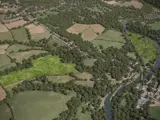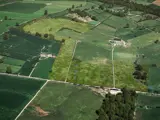Bingfield Habitat Bank, Northumberland
Local planning authority (LPA): Northumberland County Council
National Character Area (NCA): Mid Northumberland
Biodiversity Units available:
Very high distinctiveness habitats
- Lowland meadows
Medium distinctiveness habitats
- Mixed scrub
Our Bingfield Habitat Bank covers a space of 20 hectares approximately 25km northwest of Newcastle city centre where we are creating an incredible site for nature recovery. There, we are establishing rich wildflower meadows and native scrubland to provide a home for a variety of native flora and fauna.
Following a thorough assessment of the site's vegetation, wildlife, geology, hydrology, soil chemistry, management history, and landscape connectivity, we determined the best possible habitats to establish and made sure these enhancements would be deliverable. We established an ecological baseline for the site using Defra’s biodiversity metric, so we can clearly demonstrate biodiversity gains over time.
This assessment enables us to generate a range of high-integrity Biodiversity Unit habitat types that will ensure robust ecological outcomes. We also offer planning support to make sure our Biodiversity Units provide an effective local BNG delivery solution for developers within the Northumberland County Council LPA area or Mid Northumberland NCA. Our Units are ready to purchase now, subject to availability.
Adjacent LPAs for cross-boundary coverage:
- Carlisle City Council
- Newcastle City Council
- North Tyneside Council
- Durham County Council
- Northumberland National Park
- Westmorland and Furness Council
- Gateshead Metropolitan Borough Council
Adjacent NCAs for cross-boundary coverage:
- Tyne Gap and Hadrian’s Wall
- Northumberland Sandstone Hills
- North Northumberland Coastal Plain
- South East Northumberland Coastal Plain
The site will become two vast lowland hay meadows, transforming the land from heavily grazed pasture with relatively low biodiversity into a thriving haven supporting a diverse mixture of native grasses and broad-leaved herbs.
The Habitat Bank will be subject to traditional meadow management practices and closed to livestock across the flowering season each year. This will allow locally uncommon wildflowers to flourish and the diversity of the sward to improve year on year.
The northern area of the Habitat Bank falls within a flood zone. By improving the soil health so that it can retain more water, the landscape’s resilience will be enhanced against the effects of climate change and flood events.
Equally, the site lies adjacent to neighbouring ponds and woodland parcels. This means that the new habitats we are creating will build vital local ecological connectivity, allowing species to disperse and populations to thrive. This will include great crested newt and brown hare.
Scrubland creation will provide ideal nesting habitat for a variety of birds including locally declining farmland species. The site is known to already support a variety of invertebrates, and the design of the Habitat Bank will support them by providing suitable habitats and connectivity with the surrounding area.
Find out the cost and availability of Biodiversity Units from our Bingfield Habitat Bank





